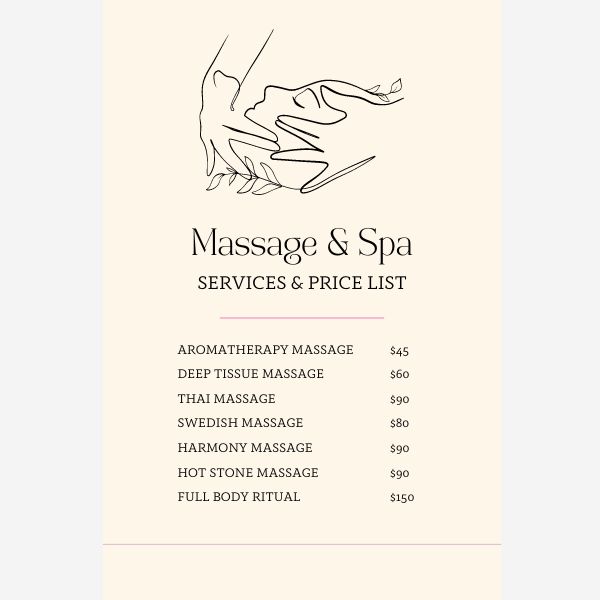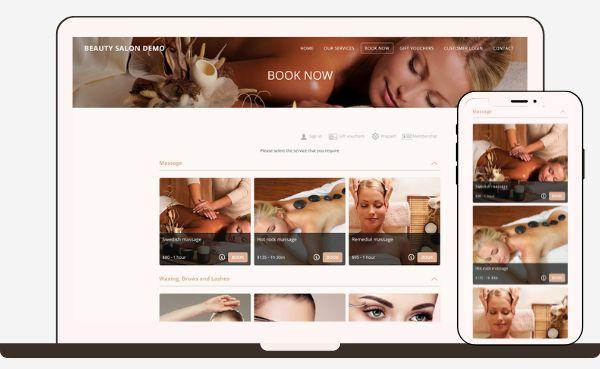
How to Write Your Ultimate Massage Business Plan
Why would you need a business plan for your massage therapy business?
For any business—not necessarily massage business—, a business plan is especially beneficial for securing funding, be it bank loans or investments.
A well-written business plan can help businesses convince banks or investors that they are worth funding. However, even if you are planning to fund your business on your own, a business plan can still bring the following benefits to your massage business:
- A roadmap to success: with a comprehensive business plan in place, you’ll have a clearer picture of what you’d like to achieve with your business. Also, it will be easier to foresee any potential obstacles so you can plan ahead on how to prevent them.
- Proves you are committed and serious: having a well-written and comprehensive business plan can give you the internal motivation to continue chasing your goals while at the same time helping you garner external support (hiring talents, securing loans, bringing in investors and partners, etc.)
- Help your team achieve their goals: having a clear business plan will help you achieve your goals much more efficiently since each team member should understand exactly what responsibilities are expected from them. Your business plan will also ensure you’ll always have future goals and milestones to look forward to, keeping your team motivated.
Not to mention, to get all these benefits, writing a business plan is very easy. You don’t need to be an expert in professional writing or have an advanced business degree to write a business plan, but anyone can write it.

Even if you don’t get it right in the first place when writing your business plan, you can always revisit and update it later: add new data, polish it with new estimations, insert updated projections, and so on.
In short, with all these benefits and the fact that it’s risk-free, there’s simply no reason not to write a business plan before starting your massage business.
Anatomy of a great massage business plan
While a business plan should be unique for each business depending on the massage business’s unique nuances, a typical business plan has the following structure:
- Executive summary. Summarizing the whole business plan, also acting as an introduction to your massage business plan.
- Business overview. Describing the business while elaborating on its objectives.
- Services and products. Listing the services and products offered by the business, including their prices.
- Industry analysis. Description of how you are going to market and promote the massage therapy business. Also, include a discussion of the size of the target market and who your target audience is.
- Customer analysis. Covers an analysis of who your business’s target audience is.
- Competitive analysis. Discussing your direct and indirect competitors.
- Sales and marketing plan. A more in-depth discussion on how you plan to sell and market your services.
- Operations plan. A discussion on how you will run the massage therapy business on a day-to-day basis.
- Financial projection. Everything about finances, from planned expenses to revenue/profit projections.
- Appendix. Supporting documentation for the massage business.
Below, we will cover these sections one by one.
1. Executive Summary
What is it?
As the name suggests, this section should include a summary of the whole massage business plan.
This section also acts as the introduction to the whole business plan, setting the context for the rest of the plan. Being the first section, it’s often the first and only section read by many readers. If this section is not attractive or engaging, the reader may skip reading the rest of the business plan altogether.

Since it’s a summary, it’s typically best to write this section last after you’ve finished all the other sections, where you can simply summarize each of the other sections.
What’s the purpose of this section?
Being the opening section of the whole business plan, the main purpose of this section is to capture the attention of the reader as soon as possible. The reader must be engaged by the executive summary, so they’ll continue reading the rest of the business plan.
However, although the main purpose is to attract, the section also has another important function to inform. From the executive summary alone, the reader should be able to understand what type of business you are going to open and its status, and at least the company’s mission, vision, goals, and basic strategy.
How to optimize this section?
- The ideal length for the executive summary is between 10% and 15% of the entire business plan document. Meaning, if it’s a 10-page document, then it should be a one-page section. However, try to be as concise as possible and don’t exceed four pages.
- Again, it’s typically better to write the executive summary once you’ve finished all the other sections. Summarize or pick important details from all the other sections to build your executive summary.
- Especially focus on communicating your business’s goals, type, operating style, strategy, and operating style.
2. Business Overview
What is it?
This section will focus on communicating what your business is and its objectives.
Begin by discussing what your massage therapy business’s core values are, what your company is, your mission, and who are going to be your target customers.
Keep the section concise and to the point, but make sure to include all the important information related to what your business is about.
What’s the purpose of this section?
The goal of this section is for the reader to understand what your business is and why you are starting it in the first place.

You should focus on the following details:
- What your business is
- What is your business going to do
- How is it going to be structured
- How are you going to operate and market your business
- Why you started the business
- What you aim to achieve through the business
- Your business milestones (if applicable, how many you have achieved so far.)
How to optimize this section?
- Write down the values that you want your massage business to represent
- Clearly elaborate on your short, medium, and long-term goals
- Discuss your target market in a detailed manner. Elaborate on how you are going to market your business to attract this target market
- Make sure to communicate how your business is structured (managerial structure) and how it is registered
3. Services and Products
What is it?
In this section, you should elaborate on the massage services that your business is planning to offer, as well as complementary products (If any) you are planning to sell. Unless you are offering too many services or products, then filling out this section should be relatively simple. Don’t forget to also add the pricing of each product and service.

What’s the purpose of this section?
Pretty self-explanatory; this section should clearly elaborate on the services and products you are planning to offer and their prices.
So:
- List every massage service (or other services) you are planning to offer in your massage business
- If you are going to sell any products (including merchandise), list them in this section
- If you haven’t already, decide on a pricing strategy and add the pricing of all the services and products listed
- If you are planning to add more products and services in the future, then you may also discuss them in this section
Most likely, you already have a list that includes the above information, so filling out this section should be relatively simple. Also, you probably already have this information on your website, so in such cases, you can simply copy-paste the information from your website.
Vice versa, if you haven’t built a website, you can use the information in this section later on.
How to optimize this section?
Here are a few tips on how to optimize this section:
- Make sure the descriptions you use for your services and products are easy to understand. Don’t use too much massage jargon, but rather, make sure to cater to as many people as possible.
- Often the most important but most challenging aspect of optimizing this section is your pricing strategy. Make sure to do your market research and competitive analysis homework so you can keep the pricing of your services and products competitive enough relative to the income level in the area.
- Overpricing your services and products may result in your business being unable to attract too many customers. On the other hand, pricing your services (and products) too low may hurt your business’s profitability, and your ideal customers may perceive your services as low-quality or “cheap.” Finding the right balance is key.’
4. Industry Analysis
What is it?
This section should cover an overview of the massage therapy industry as a whole.
Doing the industry analysis on your own can be quite challenging, and most likely, you’ll need the help of others to gather the information or use the information that’s already available elsewhere (i.e., from Statista.)

Nevertheless, the focus of this section is to provide the reader with insights into the industry, and especially how your business can compete in this industry.
What’s the purpose of this section?
For your business, this section can help you understand the general situation of the location you are going to do business. For example, if the neighborhood is ideal for the massage business to succeed.
You should also be able to gain at least a rough estimation of the size of your target audience in your area: whether the competition in the specific location is too stiff or whether it’s manageable according to your timeline and budget.
You may also gain insights into the possible growth rate of the target market in the chosen location.
How to optimize this section?
A very important consideration when filling out this section is to only use valid and comparable data. Even then, make sure the data is presented correctly so that it won’t confuse your readers.
Here are some important data to include in this section:
- The size of the massage industry in your area
- The target market size in your area
- The growth forecast of the massage therapy industry over the next 5 to 10 years
- Who are your key competitors in this market
- What trends are affecting the massage industry in your specific area?
- Is market penetration growing up or down?
5. Customer Analysis
What is it?
A continuity from the previous section, this section focuses on the discussion regarding your target audience.
Typically this section will include three different parts:
- Who is your target clientele
- An in-depth analysis of your target clients’ needs, preferences, pain points, and requirements
- Describe how your business and the services you’ll provide can solve their problems and cater to their pain points
What’s the purpose of this section?
The purpose of this section is to communicate to the reader of your market choice and to prove that you are targeting an ideal market that is not too competitive or too broad.

For your business, proper customer analysis will also provide some key benefits as follows:
- It lets you focus on serving an ideal target clientele rather than wasting your resources on a non-ideal audience
- Allows you to further devise a marketing strategy that is effective in targeting this target clientele
- If you are targeting multiple target audiences, it can also help you in prioritizing which segment you need to focus on first
How to optimize this section?
Make sure to:
- Gather as much information as you can about your target audience: demographics, geographic location, income levels, specific needs, pain points, and so on.
- Set your pricing strategy according to your target audience’s situation and income level. Again, find the sweet spot rather than overcharging or undercharging.
- Understand your target clientele’s decision-making process, and cater to this section
- Consider future projections so you can also devise an effective strategy for the future
6. Competitive Analysis
What is it?
This section will elaborate on your analysis regarding the direct and indirect competitors you may face. Direct competitors here refer to other massage businesses in your area, while indirect competitors can be other service businesses that can act as a substitute for massage service (i.e., acupuncture, spa, chiropractic, health clubs, etc.)
Other massage services that are relatively far away from your location but can be an attractive option for your target clientele (i.e., famous therapists, more affordable services, etc.)
You may also include prospective competitors that may show up in the near future.

What’s the purpose of this section?
- Know how your massage business can compete in your locality’s competitive landscape. What are your strengths? What are your business’s weaknesses and vulnerabilities? What are the unique benefits only you can offer?
- Identifying your competitors’ weaknesses so you can set up your business to offer those not offered by your competitors
- Studying your competitors (how they operate, how they market their business, etc.) can help you find new ideas and strategies for your business.
How to optimize this section?
- Open this section by outlining your business’s competitive landscape by mentioning your direct and indirect competitors, the market share they currently control, and other important details you’d like to include
- Clearly list your competitive advantages and areas where you’ll face disadvantages (and potential solutions)
- This doesn’t have to be an overly long section, but you should include enough information to convince the reader that you’ve understood who your competitors are and that you aren’t going into the industry blindly.
7. Sales and Marketing Plan
What is it?
Pretty self-explanatory, this section should discuss how you plan to market, promote, and sell your services to your target clientele.
This should be a relatively long section where you break down the entire marketing strategy and processes so your reader can study them extensively.
What’s the purpose of this section?
The main purpose of this section is to convince your readers that you have a plan in mind for how you’ll market your business and win your customers. So:
- List all the marketing strategies, tactics, and initiatives you intend to implement and elaborate on your reasoning behind each tactic. For example, if you’d like to focus on social media marketing, back it up with data that your target customers are actively using social media.
- Identify and list the requirements (resources, manpower, technology solutions, etc.) that you would require to perform all the planned marketing and sales initiatives
- Plan the human resources side of the sales/marketing initiatives. Decide whether you’ll need outside help in executing this marketing strategy (i.e., outsource graphic designers, digital marketing consultants/agency, etc.)

How to optimize this section?
- Start by including a comprehensive buyer persona for your target clientele based on your customer analysis in the previous section
- List your services in detail, as well as the products/merchandise you are planning to sell. Also include the prices that you are planning to charge.
- Focus on elaborating on how you are planning to attract clients to your business when discussing what marketing channels/tactics you are planning to use.
8. Operations Plan
What is it?
This section should discuss how you are planning to run your massage business on a day-to-day basis. Connect what you’ve discussed in your marketing plan to elaborate on how you will manage your team, manage your business’s service excellence, interact with your clients, manage your appointment booking, and so on.
What’s the purpose of this section?
The focus of this section is to make sure your reader can get an accurate understanding of how your business operates.
Explain how you will meet your milestones and objectives (as you’ve discussed in the previous sections.)
In this section, you may also want to list out different pieces of equipment and technology solutions you may use in your day-to-day operations. For example, you may elaborate on how online booking software for massage therapists can help streamline your operations and improve the guest experience.

How to optimize this section?
- Discussing how your day-to-day operation works can be confusing for readers (both internal and external readers.) It’s recommended to make this section as easy to read as possible, for example, by making it a step-by-step guide. Doing so can also allow you to easily convert this section into a staff training manual If needed.
- Focus on accuracy. Make sure the steps of operation described In this section are clear and accurate.
9. Financial Plan
What is it?
Again, this section should be pretty self-explanatory. It should cover every aspect of your finances, from the planned budget, justifications for your budget, overheads, and financial projections.
This section should aim to be as accurate as possible while at the same time always planning for the worst.
What’s the purpose of this section?
This section is especially important if you are planning to use the business plan for securing funding. In such cases, this section should help your readers (future investors, bankers, partners, etc.) to understand:
- How much money will you need
- How much money will you make
- How do you intend to use the money
By understanding these, they can make their decisions about whether they’d like to invest in your business or give you a loan.

You should also create a comprehensive financial projection describing:
- Potential sources of revenue
- How much money are you projecting to make
- The strategies to achieve this number
Last but not least, this section should also include justifications for your budget. To do so,
you should focus on three key components: income statement, balance sheet, and cash flow projection.
How to optimize this section?
People hate numbers, so you might want to help this section be more digestible and engaging by including visual elements like charts or infographics.
Also, remember that this section should cover the past (accounting), present (budgeting), and future (projection.)
10. Appendix
What is it?
This section is not mandatory, but most business plans can be enhanced by including supporting documentation to the business plan, like charts, reports, visual assets, etc.
What’s the purpose of this section?
You can use supporting documentation to give context to the projections given in the business plan (i.e., financial projection, industry analysis) and also to make the body of the business plan less cluttered.
How to optimize this section?
Here are some ideas on what to include in this section:
- Team and management information. Management structure, team members’ experience, qualifications, etc.
- Architectural plan. Plan for the massage center, etc.
- Documentation. Registration documents, compliances, patents, trademarks, etc.
- Reviews and testimonials. Testimonials from your past customers (i.e., from other businesses you’ve had)
Wrapping up
Now that we’ve learned how to write a business plan for your massage business, you are ready to create and use the business plan as your guide to achieving your business objectives.
Remember that your business plan doesn’t have to be set in stone. You can always go back to it and revise it as your business grows. Treat the time you’ve used formulating and writing the business plan as an investment to help you achieve success.


